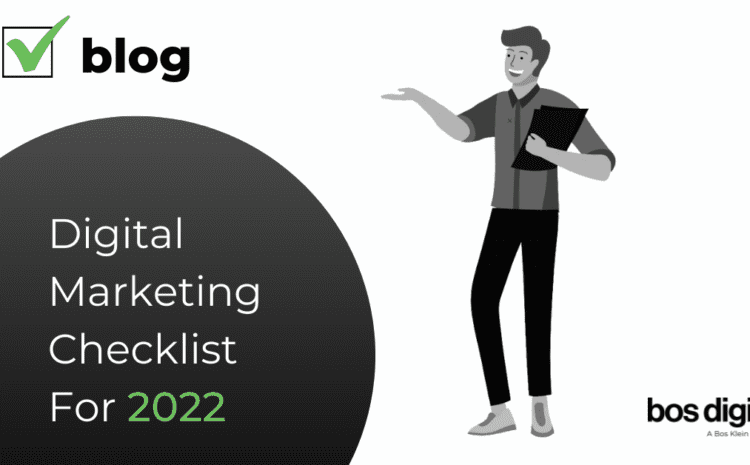Digital Marketing Checklist For 2022
Managing your digital marketing with a checklist ensures that you will stay on track this year. Like any other initiative your business undertakes, having a process and monitoring your progress allows you to make adjustments as necessary and ultimately reach your goals.
We understand that the digital space can be overwhelming and complex; it moves at a fast pace and offers a multitude of options to reach your target audience. Let’s take a closer look at those options one by one.
1. Website
Your website is one of your key digital assets. Oftentimes it’s the first introduction to your business for visitors so ensuring their experience is optimal is a priority. Not only should it reflect your brand identity and voice, it should also be user-friendly, provide the solutions and answers your target audience needs, and have clear call to actions to capture leads and convert them into customers or clients.
These are all functions of your website that affect the user experience but don’t forget, to find your website in the first place, your website needs to be found by search engines. This is where search engine optimization (SEO) comes into play. Here are some of the important SEO practices you need to do:
- Adding location pages to your website will ensure anyone searching locally for your business will find you
- Adding a sitemap to your website helps search engines understand the totality of your website
- Adding Google Analytics and Google Tag Manager helps you understand the traffic to your website, the behavior of your visitors, and ultimately how to improve both. By the way, Google Tag Manager is a simple container used to hold the Google Analytics code and other tracking scripts like the Facebook pixel and helps with your website speed by deploying all these codes at the same time.
- Setting up Google Search Console for your website allows you to see which keywords you are ranking for in search results. This in turn gives you insights into what content you need to create on your website in order to improve your ranking results.
- Creating searchable content around keywords can be achieved through blog posts and if applicable by adding specific products or services to your website.
- On-page SEO is the process of optimizing the pages of your website with relevant title tags, meta descriptions, alt tags for images, and focus keywords. If your website is built with WordPress we recommend using the YOAST plugin to handle on-page SEO.
- Link building SEO is a longer-term strategy but one of great value. By developing and growing links to your website from other relevant and authoritative sites you increase the authority of your website which in turn helps you rank higher in search engine results pages (SERPs).
- Optimizing your website for voice search has become a necessity because of the extensive use of devices like Alexa, Siri, and Cortana to name a few. Schema code dropped on your site allows these devices to recognize the content on your site and deliver your site to voice search queries.
2. Google My Business
As the number one search engine Google provides a listing service called Google My Business (GMB). It is free to all businesses and helps people who find you via search or Google Maps learn more about your business with photos, offers, posts, and more.
By the way, having a claimed and optimized GMB profile accounts for upwards of 25% of your ranking value in local search results. Here are the basics steps of optimizing your profile:
- Claim or create your listing on Google My Business
- Optimize your profile with accurate data such as your business name, address, phone number, hours of operation, etc.
- Select the categories that best represent your business and what you do
- Add your products and services with keyword rich descriptions to help your business be found in search queries
- Add photos of your business in each of the categories defined in your profile (eg. interior, exterior, at work, team, etc)
- Add videos directly to your profile to showcase your company
- Create weekly posts to let visitors know what’s new, any promotions you are offering, and to expand on what you do. These posts have a direct impact on your search engine rankings so do not overlook the importance of consistently adding new posts to your GMB profile. It works!
3. Business Listings (also known as Citations)
The information about your business is found not only on your website, Google My Business and any social media channels you have set up but did you know there are business listing sites that also display your information? Some of these sites you know, like Yelp, Trip Advisor, Better Business Bureau, and Angi (formerly Angie’s List). Others are more obscure but just as important when it comes to serving up accurate information about your business. When your Name, Address, and Phone Number (collectively known as NAP) are inconsistent across the web, your rankings in search suffers. Here is what you can do to remedy that:
- Check listings on all major directories
- Detect and resolve inconsistencies in your listings on all directories.
- Get on industry-specific directories like Clutch, Expertise, etc. We’ve noticed a marked increase in the value of these types of listing sites in search engine page results. These directories should not be overlooked by any business serious about being found online.
Pretty well all of these business listing sites allow visitors to leave reviews, which is another reason why claiming these directories is important. By monitoring and responding to reviews you help build the relationship with your customers and clients. And the more positive reviews you get will help improve your overall rating and attract more leads.
Bonus: Adding these positive reviews to your website also helps validate your reputation.
4. Social Media
Tackling social media may seem daunting with the ever growing channels and features of each platform. The way to approach social media is knowing who your target audience is and what channels they prefer to use. For instance, LinkedIn is primarily a B2B channel with an older demographic, Instagram’s largest audience is in the 25 to 34 age bracket and engages highly in influencer and shopping content, while Tik Tok, the newest “kid on the block”, appeals to a younger audience between the ages of 18 to 24 but the platform is seeing an increase in subscribers in the older age brackets and the adoption by certain brands. Here are some steps you can take on social media this year:
- Create and optimize the best social media channels for your brand. This includes making sure your banners, logos, business information are accurate and sized correctly and that you are taking advantage of all the features available (eg. Instagram highlights, YouTube playlists)
- Develop a strategy and content calendar around relevant topics of interest for your target audience. This will ensure your social media channels have a consistent flow of content which helps build engagement and credibility for your business.
- Engage with your audience by replying to any comments. Your content should be encouraging engagement as well by asking questions either in the form of polls or surveys or simply asking people what they think!
- Expand your social media reach with paid advertising (see below)
5. Paid Advertising
Paid advertising can either be search or social advertising. As the name suggests, search advertising allows you to attract new customers through targeting search queries with your ads. Typically these are Google ads but Bing also provides an ad platform. Social advertising uses the ad platforms of the various social media channels to put you in front of your target audience. As you can see, the way your ad is found on search is very different from how it is found on social media. Therefore the goals of each form of advertising need to be different. Think of search advertising as providing solutions to people actively looking for answers, while social advertising is getting your “idea” in front of people who may not yet know they are looking for you! Here are some things to consider when you are creating your paid advertising campaigns.
- Create ad campaigns to meet the needs of your target audience. By doing keyword research you can identify the correct keywords to use in search ads. Understanding the demographics and social behavior of your target audience will help you identify the appropriate social media channel, the correct demographics and the target area.
- Use correct call-to-actions. For example,. don’t say “call now” if no one will be there to pick up the phone.
- Make sure your ad copy uses the appropriate tone and messaging of your brand.
- Setup and optimize your ad platforms for accurate tracking of results. This includes putting proper pixel codes in place.
- Create optimized landing pages to maximize conversions.
- Put call tracking in place to monitor calls and conversions.
6. Email Marketing
Even though email is a more traditional approach to digital marketing it is still a very effective way to reach your audience and provides an opportunity to personalize the content you are delivering. By collecting email addresses, either on your website or directly from your clients and customers, you can market your business with monthly newsletters, offers and promotions, and other relevant content such as events, webinars, etc. Here are a few things to keep in mind to make sure your email marketing hits the mark.
- Segment your email list and create email content relevant to match the interests of your audience. This practice will help your emails seem less spammy, helping your unsubscribe rate stay low.
- As mentioned above, personalizing your email campaigns is an opportunity you don’t want to miss. Know what your audience wants by asking them! And then taking the feedback and creating emails your audience wants to receive. Don’t forget to also ask how often they want to hear from you.
- Using email marketing automation software allows you to be very efficient and scale your efforts. This kind of software provides the ability to create drip email campaigns which is a great way to deliver the content your audience is looking for, when they are seeking it.
- A/B testing is another way email marketing helps you evaluate your content and know what adjustments to you may need to make.
No matter what stage your business is in, startup or seasoned, your digital marketing efforts can greatly improve your bottom line. Having a plan and a checklist will keep you on track to meeting or exceeding your goals in 2022.
If you need help in one or more of these digital marketing activities don’t hesitate to reach out to us. We have a team of seasoned subject matter experts ready to assist your business.








